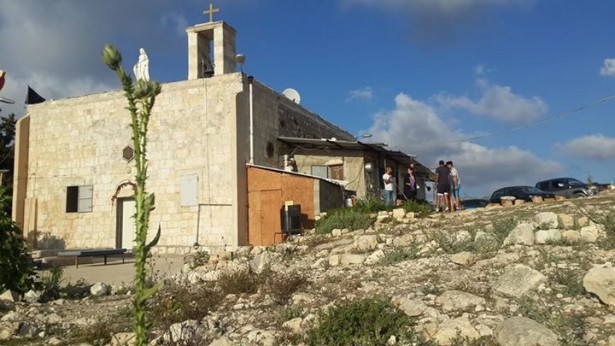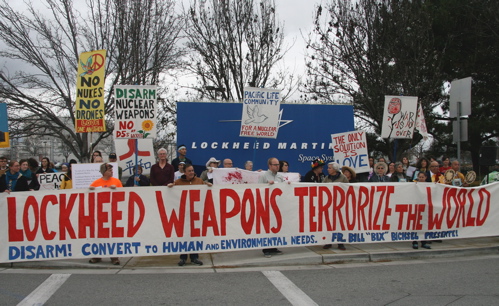by George Lakey

Poster art courtesy wrongkindofgreen.org
Editor’s Preface: This previously unpublished essay was a paper presented at the International Conference of Peace Researchers and Peace Activists (Noordwijkerhout, Netherlands, July 1-6 1975), and is another in our series of important discoveries from the War Resisters’ International archive. Please see the notes at the end for archival information, and for a note about George Lakey. JG
Training for peace action is a fairly new phenomenon. By training I mean the systematic sharing of skills and knowledge. Activists in former years could learn by apprenticing themselves to experienced leaders, or could pay special attention to those conferences and institutes featuring nonviolent organizers. But there was nowhere they could go to get systematic, long-term training.
The burst of nonviolent action in the nineteen-sixties stimulated people in a number of countries to seek to remedy this. In 1965 the first international conference on training for nonviolent action was held in Perugia, Italy, by War Resisters’ International. Activists came from as far away as India and the U.S. to compare notes on training experience.
Read the rest of this article »
by A. J. Muste

Poster quote courtesy griid.org
This article is in the first instance an appeal to those, Negro and white, who are taking part in the movement for civil rights in the United States today in 1964. It is an appeal that in considering how to deal with the agonizing and complicated problems which now beset it the emphasis shall be on nonviolence, i.e. on maintaining the spirit of nonviolence in the movement and in devising apt and imaginative applications of a basically nonviolent strategy.
During the long hot summer of 1964, about which we had been warned or with which we had been threatened, the violence and tension were focused largely on Mississippi where three young men who volunteered to work in the Council of Federated Organizations (COFO)campaign for voter registration and related objectives simply disappeared. It was in Mississippi that Medgar W. Evers, the devoted and highly respected organizer of the National Association for the Advancement of Colored People (N.A.A.C.P.), was brutally assassinated. No one has been convicted of that crime in the courts of that state. It was in Jackson, Mississippi, that the widow of Medgar Evers at his memorial service said to her fellow Negroes and fellow workers, “We must not hate; we must love”. What I am trying to say in what follows is that this statement must be the light that guides the movement in the dark passages and the motto on its banners as it moves into the light.
Read the rest of this article »
by Theodore Olson

Poster art courtesy occupysantacruz.org
Editor’s Preface: This unpublished essay was a paper presented at the study conference Training in Nonviolence (Perugia, Italy, 13-20 August 1965) under the joint auspices of War Resisters’ International, and is another in our series of rediscoveries from the WRI archive. Please see the notes at the end for further archival references, a link to a pdf scan of the original, and biographical information about the author. JG
By nonviolent training we mean conscious attempts, in the context of teaching and learning, to impart historical experience, general concepts, technical skills and personal experience in how to act effectively and nonviolently in conflict situations. By “nonviolently” we mean to stress programmatic or active nonviolence, as exemplified by, but not restricted to, social action struggles: for example, Gandhi’s actions in India and that of the peace and civil rights activists in the United States.
Read the rest of this article »
by Melanie Nakashian

St. Mary’s church, Iqrit; courtesy wagingnonviolence.org
Editor’s Preface: The story of the decades-long nonviolent protest in the village of Iqrit, northern Israel, is one we have previously covered, and can be found at this link. Indeed, our previous article, from our WRI research project, was written in 1974, to cover a nonviolent protest that had already been going on for several years. That the inhabitants have resorted to the courts and symbolic acts of protest such as planting trees and gardens, but have remained nonviolent, is one of the more remarkable stories of contemporary nonviolent protest. JG
Among the hundreds of Palestinian villages that were evacuated between 1947 and 1951, there is one whose descendants are actually getting close to fulfilling their right of return. In an unprecedented case, the demolished Christian village of Iqrit should soon be connected to Israel’s electricity grid. This comes just as a group of Iqrit’s young descendants mark three years, this August 5 [2015], of continuously inhabiting the church in their otherwise destroyed village.
Read the rest of this article »
by Judith Mahoney Pasternak

Book jacket art courtesy tadweenpublishing.com
If you follow the Western media, the news from Iraq is almost always bad. A quarter century of war, including 13 years of brutal sanctions, invasion, a no less brutal eight-year occupation, an externally imposed, undemocratic and repressive government, and now the attempt by the Islamic State to remake Iraq in its image — all have resulted in millions of deaths, and the toll keeps rising. “Such a bruised country! No society can withstand such pressure,” declares Indian journalist Vijay Prashad in his foreword to Against All Odds: Voices of Popular Struggle in Iraq [Washington, D.C. and Beirut: Tadween Publishing, 2015].
Yet there is another side to the story of Iraq, one that has been rendered all but invisible in the media, which seem to have no room for the words “hope” and “Iraq” in the same sentence. In February of 2011, in the wake of the Arab Spring, the hunger for a better future for Iraq — a hunger that had been repressed but never suppressed — arose again in force in cities across the ravaged country, in the form of a decentralized mass nonviolent protest movement. Against All Odds is the story of that movement, told in part by War Resisters League organizer and writer Ali Issa, and in part by eight leaders of different segments of that movement.
Read the rest of this article »
by Stephen Zunes and Noor Al-Haidary

Yemeni protesters wear pink as symbol of nonviolence; courtesy went2thebridge.blogspot.nl
As with the 2011 uprising against the Saleh regime in Yemen four years ago, an unarmed civil society movement is now (April 2015) rising up to challenge the Huthi militia. While media coverage of the tragic situation unfolding in Yemen in recent months has focused on armed clashes and other violence, there has also been widespread and ongoing nonviolent civil resistance employed by a number of different actors. In fact, the most significant setbacks to the Huthi militia in their march southward across the country in recent months have come not from the remnants of the Yemeni army or Saudi air strikes, but from massive resistance by unarmed civilians which has thus far prevented their capture of Taiz, the country’s third largest city, and other urban areas. The resistance efforts have also pressed the Huthi to withdraw their forces from a number of previously held areas, including universities, residential neighborhoods, and even military bases. This kind of nonviolent resistance by ordinary people is remarkable, but it is not new in Yemen.
Read the rest of this article »
by Matt Dundas

Bypass Protest banners near Vandenberg weapons test site; courtesy vandenbergwitness.org
On August 12, 1982, the US Navy submarine USS Ohio barreled in to Puget Sound. It was the end of its long journey from Groton, Connecticut, through the Panama Canal, and up the west coast of North America. (1) The Ohio was the first of a new class of submarines intended to house the Navy’s newest nuclear weapon: the Trident missile. (2) Mixed emotions greeted the Ohio at the newly expanded Bangor military base on Washington’s Kitsap Peninsula. Some were eagerly anticipating the boat, elatedly waving American flags, dancing to the Navy band, and cheering on the sailors. (3) Others waited anxiously, as they had for days, to create a peace blockade of “ridiculous little boats” in an effort to stop the 560-foot-long, four-story-high Ohio from docking. (4)
Read the rest of this article »
by Matt Dundas

Anti-Trident protest, Vandenberg test site; courtesy www.salem-news.com
During the height of the Pacific Life Community (PLC) and Ground Zero’s campaign, other campaigns around the country were gaining steam as well. They had a tactic in common with PLC and Ground Zero: nonviolent direct action. A prime example was the Clamshell Alliance, founded in 1976 in response to the planned nuclear power plant in Seabrook, New Hampshire, in a campaign that saw the arrests of more than 1,400 people during its biggest action. (59) Historian Barbara Epstein wrote, “The Clamshell Alliance combined small-group structure and consensus process with nonviolent civil disobedience.” (60) Indeed, PLC and the Clamshell Alliance were building on similar ideals, joined by other campaigns such as the Abalone Alliance in San Luis Obispo, California, which had 1,900 arrested at a local nuclear power plant; (61) and the Livermore Action Group, near San Francisco, where 777 were arrested for entering a nuclear test site. (62) Nonviolent direct action had become the dominant tactic in American activism.
Read the rest of this article »
by Terry Messman

March 2015 anti-nuclear weapons demonstration, courtesy vandenbergwitness.org
Jim and Shelley Douglass helped to organize one of the nation’s most significant and multifaceted campaigns of nonviolent resistance when they uprooted their lives, left their home behind, and literally moved right next door to Ground Zero of the nuclear arms race, in a home adjacent to the Bangor Naval Submarine Base in Kitsap County, Washington. Their new next-door neighbors were a fleet of Trident submarines and an unimaginably destructive stockpile of Trident missiles in weapons bunkers. In the interview posted here, Jim Douglass has starkly described the genocidal power of this weapons system. “A single Trident submarine could destroy an entire country. A fleet of Tridents could destroy the world.”
Read the rest of this article »
by Terry Messman

Book jacket art courtesy wipfandstock.com
A reporter warned Jim Douglass that he had observed a train north of Seattle that looked like it was “carrying big-time weapons.” The reporter added that the heavily armored, all-white train looked like “the train out of hell.”
Dorothy Day, the co-founder of the Catholic Worker, has been a lifelong source of inspiration for James and Shelley Douglass, both in their nonviolent resistance to war and nuclear weapons, and also in their solidarity with poor and homeless people. Day devoted her life to the works of mercy for the poorest of the poor, and often quoted Fyodor Dostoevsky on the high cost of living out the ideal of love in the real world. “As Dostoevsky said: ‘Love in action is a harsh and dreadful thing compared with love in dreams.’”
The same warning might be given to those who try to live out the ideal of nonviolence in action, since love and nonviolence are essentially one and the same. One of Mohandas Gandhi’s descriptions of nonviolent resistance is “love-force.”
Although it may be heartening to read about nonviolence in the lives of Martin Luther King, Gandhi, and Dorothy Day, it is a “harsh and dreadful” proposition to engage in actual resistance to a nuclear submarine capable of destroying hundreds of cities, and protected by the most powerful government in the world. Instead of nonviolence in dreams, one faces nonviolence in handcuffs and jail cells, nonviolence sailing in the path of massive submarines, nonviolence on the tracks blockading “the train out of hell.”
Read the rest of this article »














